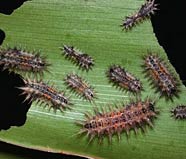Nettle Caterpillar
Nettle caterpillar (Darna pallivitta)
Regulatory Status: Pest for Control (HAR 69A)
Prevention and Control Category: The Hawaiʻi Department of Agriculture and U.S. Department of Agriculture introduced a biocontrol agent to control nettle caterpillar in 2010. The biocontrol agent, a wasp introduced from Taiwan, is a natural enemy of the caterpillar and has helped to manage nettle caterpillar infestations.
Description
The stinging nettle caterpillar is the 1st larval form of an Asian moth. It is covered with rows of poisonous spines. The coloration is variable, ranging from white to light grey, with a dark stripe running down the length of the back. Populations peak during the summer months.
Impacts
This caterpillar produces a painful sting filled with a burning, itching sensation and may cause an allergic reaction. The skin will swell and create a welt that may last for days followed by a persistent rash that may last for weeks. In the nursery industry, stinging nettle caterpillars feed upon and damage crops. It is found to feed and breed on coconut, mondo grass, ti plants, areca palm, Dracena spp., fishtail palm, rhapsis palm, walking iris, banana, honohono grass, and a number of other plants.
Distribution
Stinging nettle caterpillars are often distributed through cargo and nursery shipments. Originally from Southeast Asia, stinging nettle caterpillars were first found on the Big Island in 2001. They likely arrived in a shipment of rhapsis palm seedlings from Taiwan and have since spread to all of the main Hawaiian islands.
What you can do
No action is required, as this species is widespread and is not part of a current control effort.
Look-alike Species
Nymphalid butterflies (Family: Nymphalidae): Some of the caterpillars from the Nymphalidae family also are covered in spines, though non-stinging. Butterflies in this family include Kamehameha butterfly (Vanessa tameame), painted lady (Vanessa cardui), red admiral (Vanessa atalanta), American lady (Vanessa virginiensis), California tortoiseshell (Nymphalis californica) and the Passion Vine Butterfly or Gulf Fritillary (Agraulis vanillae).
For additional information, visit:
-
HDOA pest advisory
